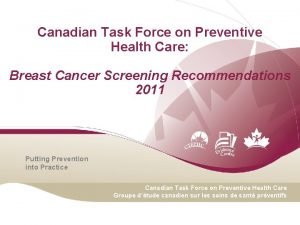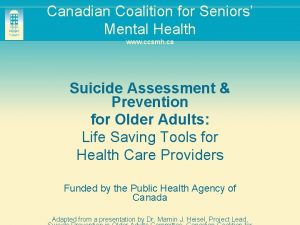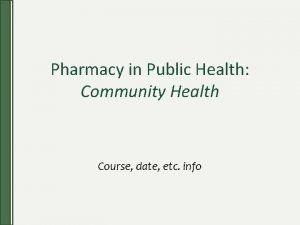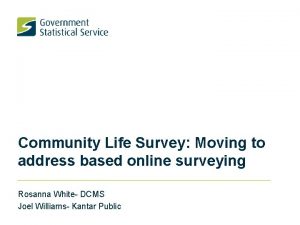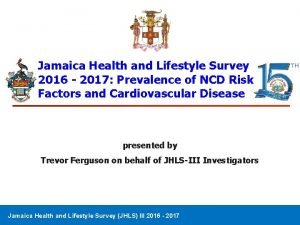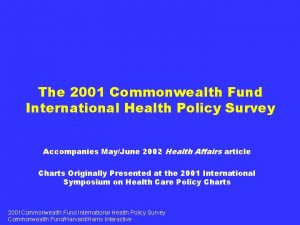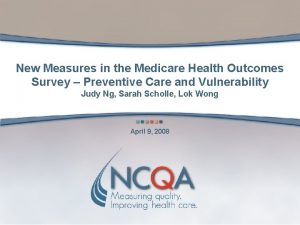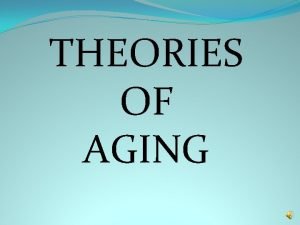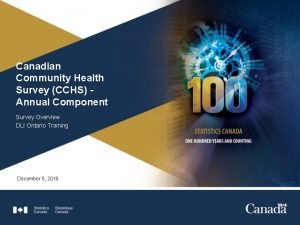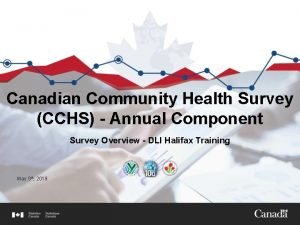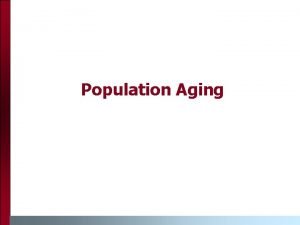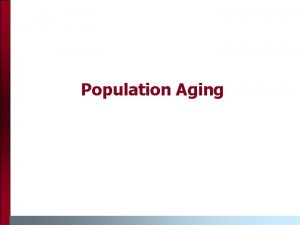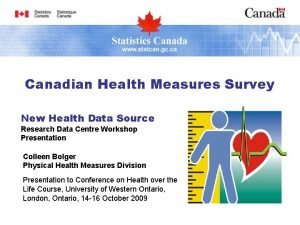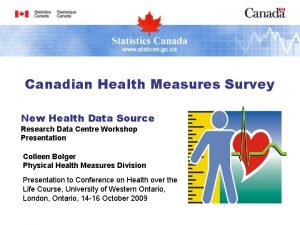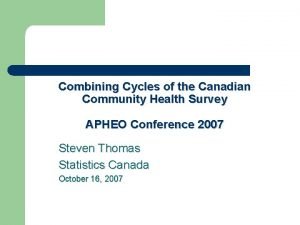Canadian Community Health Survey CCHS Healthy Aging Data



























- Slides: 27

Canadian Community Health Survey (CCHS) – Healthy Aging Data Liberation Initiative Webinar Leslie Geran Health Statistics Division, Statistics Canada April 2011

Presentation overview § § § § CCHS survey program Objectives Content Data collection / processing Products / documentation Analysis Canadian Longitudinal Study on Aging (CLSA) Questions?

Canadian Community Health Survey Program Annual Focus Content Component Special Projects e. g. CCHS Healthy Aging e. g. Survey of living with chronic diseases in Canada e. g. CCHS 2009

Seniors by age as a percentage of the total population, Canada, 1951 -2051

Survey objectives § Examine links between various types of health and well-being with social, lifestyle, labour force, and economic factors as well as health care utilization; § Identify determinants of healthy aging in Canada at different stages of life; § Explore the needs of an aging population; and § Understand the aging process by age group and sex.

Survey design and coverage § National and provincial estimates § ~ 31, 000 respondents aged 45 and over living in private households in 10 provinces § Cross-sectional § Voluntary participation with proxy interviews allowed § Personal interviews (CAPI)

Design exclusions § § § Persons living in the three territories Those living on Indian Reserves/Crown lands Full-time members of the Armed Forces Residents of certain remote regions Residents of institutions

16. 0% 14. 0% Population in health-related collective dwellings, Canada, 2006 12. 0% 10. 0% 8. 0% 6. 0% 4. 0% 2. 0% 0. 0% Total Under 15 15 -34 35 -54 55 -64 Male female Both sexes Source: Statistics Canada - 2006 Census. Catalogue Numbers 97 -554 -XCB 2006054 and 94 -575 -XCB 2006001. 65 -74 75 and older

What is healthy aging? § A lifelong process for improving and preserving health and physical, social and mental wellness, independence, quality of life and enhancing successful life-course transitions (Health Canada, 2001) § Need a multidimensional perspective that includes both health and non-health elements

Survey content Physical health and functioning § General health § Basic Activities of Daily living § Instrumental Activities of Daily Living § Chronic conditions § Health Utilities Index § Pain and discomfort § Falls § Oral health § Medications

Survey content Cognitive and Psychological Health § Cognition (*2 nd release) • Assessed through 4 tasks § Depression • CIDI-SF § Loneliness • 3 -item loneliness scale (M. H. Hughes) § Satisfaction with life scale (E. Diener)

Survey content Social dimensions § Social participation § Social support availability Health care and care giving § Health care utilization § Caregiving, Caregiving expenses § Care receiving 1 (formal) § Care receiving 2 (informal) Lifestyle/behaviours § Physical activity (PASE) § Nutritional risk § Smoking § Alcohol use § Dietary supplements § Changes made to improve health § Transportation

Survey Content Labour Force, Retirement, Income § Labour force § Reasons for retirement § Retirement planning § Home ownership § Income Other § Socio-demographic characteristics § Education § Dwelling

Data collection and processing § § Collection: Dec. 1, 2008 – Nov. 30, 2009 62 minute average interview Response rate 74% Cognition module had lower response 62% • Only administered in person (no proxy, no telephone), in French or English, with permission for voice recording • Separate sample weight required • Further validation was required: See Findlay F et al. “Validation of cognitive functioning categories in the Canadian Community Health Survey – Healthy Aging” in Health Reports (catalogue 82 -003) December 2010

Master file structure Cognition file N=25, 864 Non-cog file N=30, 865 15 Statistics Canada • Statistique Canada 11/1/2020

File release dates Non-cognition Cognition Master file May 12, 2010 December 12, 2010 Share file May 12, 2010 December 12, 2010 Public Use Microdata File (PUMF) April 1, 2011 Synthetic (dummy) file March 4, 2011 CLSA share file May 12, 2010 December 12, 2010 X

Survey documentation / metadata § Documents: • • Questionnaire Derived variables User guide Data dictionary for each file • Record layout for each file § Further information and access • IMDB record # 5146 (link through STC “Health in Canada” portal). www. statcan. gc. ca • DLI webpage for PUMF and synthetic files • RDC webpage for master files • PUMF file CD-ROM also available by request (free)

Tabular data in CANSIM Table 105 -1200 (released May 12, 2010) 14 items by age group, sex, province • Chronic conditions (cataracts, glaucoma, osteoporosis, thyroid condition, at least one chronic condition) • Social participation (family and friends, religious activities, sports and physical activities, volunteer activities, participate at least once a month) • Sleeping trouble • Nutritional risk • Mouth unhealthy • Falls (65 years of age and over)

• Source: 2008 -2009 Canadian Community Health Survey – Healthy Aging

Analytical release § “Health-promoting factors and good health among Canadians in mid-to late life” by Pamela Ramage-Morin, Margot Shields and Laurent Martel in Health Reports (Catalogue no. 82 -003 -X) – July 21, 2010 § http: //www. statcan. gc. ca/pub/82 -003 x/2010003/article/11289 -eng. htm

• Source: 2008 -2009 Canadian – Healthy Aging Source: 2009 Canadian Community Health Survey –Healthy Survey Aging.

% In Good Health • Source: 2008 -2009 Canadian Community Health Survey – Healthy Aging Source: 2009 Canadian Community Health Survey – Healthy Aging.

Analytical release § “Retirement, health and employment among those 55 plus” by Jungwee Park in Perspectives on Labour and Income (Catalogue no. 75 -001 X) – January 31, 2011 § http: //www. statcan. gc. ca/pub/75 -001 x/75 -001 -x 2011001 -eng. htm

Older Canadians see themselves as being able to work • Population age 55 to 84 • Source: 2008 -2009 Canadian Community Health Survey – Healthy Aging • Data for fully and partially retired are significantly different from never retired before and after age -sex adjustment (p<0. 05)

Freedom 55? Age at first full or partial retirement, or planned age of retirement for the never-retired • Population age 55 to 84 • Source: 2008 -2009 Canadian Community Health Survey – Healthy Aging

CCHS - Healthy Aging and the Canadian Longitudinal Study on Aging (CLSA) § The CLSA experts contributed to content development § CLSA funded sample for ages 45 -54 § CLSA are contacting consenting CCHS respondents (ages 45 to 85) to invite them to participate in their longitudinal survey § CLSA will receive CCHS survey responses of consenting respondents (CLSA share file) § www. clsa-elcv. ca

Questions? Data Liberation Initiative listserve dlilist@statcan. gc. ca STC Health Statistics Division Client Services 613 -951 -1746, hd-ds@statcan. gc. ca
 Cchs 165
Cchs 165 Wisconsin institute for healthy aging
Wisconsin institute for healthy aging Nutrition and productivity
Nutrition and productivity Healthy soil healthy life poster ideas
Healthy soil healthy life poster ideas Healthy community poster
Healthy community poster Healthy nurse healthy nation
Healthy nurse healthy nation Canadian community economic development network
Canadian community economic development network Canadian association for community living
Canadian association for community living Ciip canada
Ciip canada Role of community health nurse in occupational health
Role of community health nurse in occupational health Abcd acls
Abcd acls Ctfphc
Ctfphc Ccsmh
Ccsmh Benefits of a healthy community
Benefits of a healthy community Characteristics of healthy community
Characteristics of healthy community Canadian geospatial data infrastructure
Canadian geospatial data infrastructure Community right to know survey nj
Community right to know survey nj Community life survey
Community life survey Jamaica health and lifestyle survey
Jamaica health and lifestyle survey Ehis eurostat
Ehis eurostat California health information survey
California health information survey Commonwealth fund international health policy survey
Commonwealth fund international health policy survey Medicare health outcomes survey
Medicare health outcomes survey European health literacy survey
European health literacy survey Bhore committee
Bhore committee Human needs theory of aging
Human needs theory of aging George carlin on age
George carlin on age Market forms and meat cuts
Market forms and meat cuts











